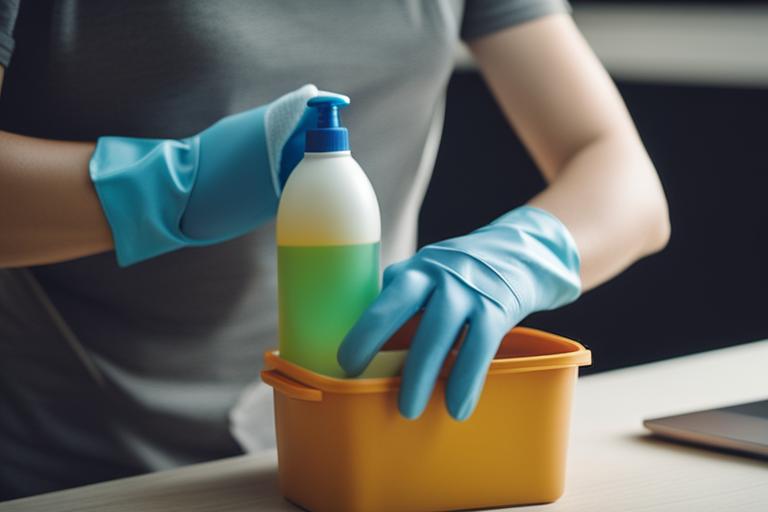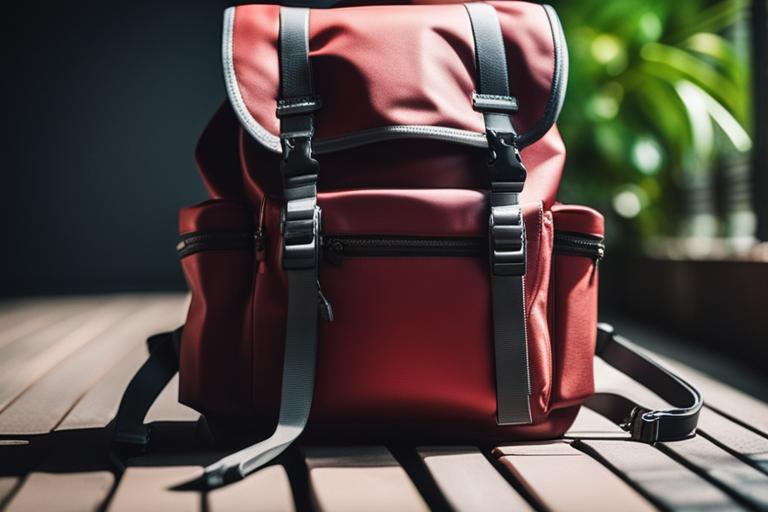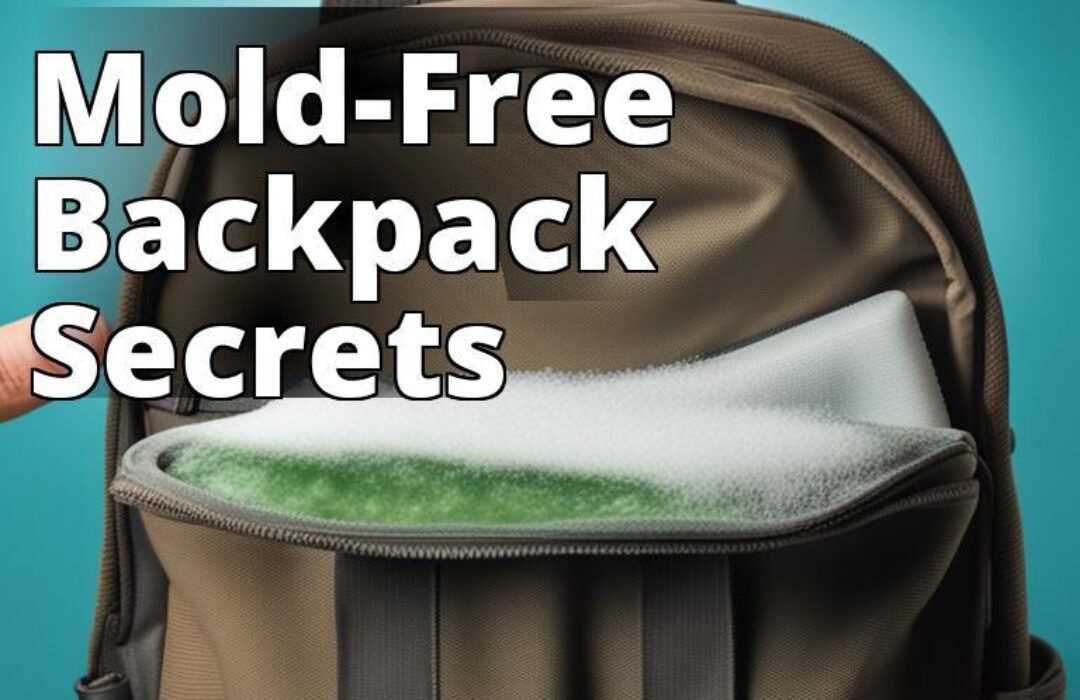What you will learn about cleaning mold out of a backpack:
- Causes of mold growth in backpacks and potential health risks associated with mold exposure.
- The necessary supplies and preparation needed for cleaning mold from a backpack.
- Step-by-step instructions on how to remove mold from a backpack and prevent future mold growth.
If you’re wondering how to clean mold out of a backpack, you’ve come to the right place. A backpack is an essential item for many people, but it can become a breeding ground for mold if not properly maintained. Mold growth not only damages the backpack but also poses potential health risks. In this comprehensive guide, we will walk you through the process of cleaning mold out of a backpack and share tips on preventing future mold growth.

Understanding Mold in Backpacks
Before we dive into the cleaning process, let’s understand why mold grows in backpacks and the common types of mold you may encounter. Mold thrives in moist and dark environments, making backpacks an ideal breeding ground. Factors such as sweating, spilled liquids, or storing damp items in the backpack can contribute to mold growth.
The most common types of mold found in backpacks include Aspergillus, Penicillium, and Cladosporium. These molds can cause allergic reactions and respiratory problems when exposed to humans. It’s crucial to clean mold as soon as it’s detected to prevent further damage and potential health issues.

Gather Necessary Supplies
Before you begin the cleaning process, gather the necessary supplies. You’ll need:
- Stiff brush or toothbrush: to remove loose mold
- Mild detergent: for creating a cleaning solution
- Warm water: to mix with the detergent
- Vinegar: an alternative cleaning solution
- Commercial mold cleaner: for stubborn mold stains
- Clean cloth or sponge: for scrubbing
You can find these supplies at your local supermarket or hardware store. It’s important to ensure that the products you choose are safe to use on the material of your backpack.
| Supplies Needed | Reasoning |
|---|---|
| Stiff brush or toothbrush | to remove loose mold |
| Mild detergent | for creating a cleaning solution |
| Warm water | to mix with the detergent |
| Vinegar | an alternative cleaning solution |
| Commercial mold cleaner | for stubborn mold stains |
| Clean cloth or sponge | for scrubbing |
| Gloves, face mask, and protective eyewear | to protect yourself from mold spores and potential allergic reactions |

Prepare for Cleaning
Cleaning mold can release mold spores into the air, which can be harmful if inhaled. Therefore, it’s crucial to choose a well-ventilated area for cleaning your backpack. An outdoor space or a room with open windows is ideal. Additionally, make sure the area is well-lit so you can see all the affected areas clearly.
To protect yourself during the cleaning process, wear gloves, a face mask, and protective eyewear. These precautions will minimize your exposure to mold spores and prevent any potential allergic reactions.
Empty and Inspect the Backpack
Before you start cleaning, empty the backpack completely. Remove all items, including books, papers, and personal belongings. Inspect each item for any signs of mold growth or damage. If you find any mold-contaminated items, set them aside for proper cleaning or disposal.
It’s essential to handle the contaminated items with care to prevent spreading mold spores. Place them in sealed plastic bags or containers until you can properly clean or discard them.
Personal Story: The Time I Discovered Mold in My Backpack
I. Introduction
A. Importance of cleaning mold out of a backpack
B. Potential health risks associated with mold exposure
II. Understanding Mold in Backpacks
A. Causes of mold growth in backpacks
B. Common types of mold found in backpacks
III. Gather necessary supplies
A. List of supplies needed for cleaning mold
B. Where to find the supplies
IV. Prepare for cleaning
A. Choose a well-ventilated and well-lit area
B. How to protect yourself while cleaning mold
V. Empty and inspect the backpack
A. Remove all items and inspect for mold or damage
B. How to handle contaminated items
VI. Personal Story: The Time I Discovered Mold in My Backpack
Last year, I went on a hiking trip with my friends to the beautiful mountains of Colorado. We had an incredible time exploring nature and taking in the breathtaking views. However, when I returned home and unpacked my backpack, I was shocked to discover mold growing inside it. It was a disheartening sight, especially considering the sentimental value of my backpack and the potential health risks associated with mold exposure.
VII. Brush off loose mold
A. Use a stiff brush or toothbrush
B. Proper techniques for brushing off mold
VIII. Prepare a cleaning solution
A. Mixing warm water and mild detergent
B. Alternative solutions: vinegar and water, commercial mold cleaner
IX. Scrub the affected areas
A. How to effectively scrub the backpack
B. Paying attention to seams, corners, and hard-to-reach spots
X. Rinse and repeat
A. Thoroughly rinsing the backpack with clean water
B. Repeating the cleaning process for stubborn mold stains
XI. Dry the backpack
A. Proper methods for drying the backpack
B. Ensuring the backpack is fully dry before storage or use
XII. Prevent future mold growth
A. Using mold-resistant sprays or inhibitors
B. Storing the backpack in a dry and well-ventilated area
XIII. Regular maintenance
A. Encouraging regular checks for mold growth
B. Tips for preventing further contamination
XIV. Additional Tips and Considerations
A. Removing mold odors from the backpack
B. Dealing with mold on backpack straps and zippers
XV. Conclusion
A. Recap the importance of cleaning mold out of a backpack
B. Emphasize the significance of maintaining a clean and mold-free backpack
In this section, I want to share my personal experience of discovering mold in my backpack after a hiking trip. It serves as a reminder that even the cleanest and most well-maintained backpacks can still develop mold under certain circumstances. By sharing this story, readers can understand the importance of regularly checking their backpacks for mold and taking the necessary steps to prevent its growth.
Brush off Loose Mold
Once the backpack is empty, it’s time to remove loose mold using a stiff brush or toothbrush. Take the brush and gently scrub the affected areas, focusing on visible mold patches. Be careful not to scrub too hard, as this may damage the backpack’s material. Use circular motions to loosen the mold from the surface.
For hard-to-reach spots or intricate details, use a toothbrush to ensure thorough cleaning. Remember to brush both the interior and exterior of the backpack, paying special attention to seams, corners, and pockets.
Prepare a Cleaning Solution
After brushing off loose mold, it’s time to prepare a cleaning solution. Fill a bucket or basin with warm water and add a small amount of mild detergent. Mix the solution until the detergent is fully dissolved. This mixture will effectively clean the mold and remove any lingering odors.
If you prefer a natural alternative, you can use vinegar and water instead of the mild detergent solution. Mix equal parts of white vinegar and water in a container. Vinegar has antimicrobial properties that can help kill mold spores.
For stubborn mold stains, you may consider using a commercial mold cleaner. Follow the instructions on the product label for the appropriate usage and safety precautions.

Scrub the Affected Areas
Dip a clean cloth or sponge into the cleaning solution and wring out any excess liquid. Gently scrub the affected areas of the backpack, applying moderate pressure. Use back-and-forth or circular motions to ensure thorough cleaning. Pay extra attention to seams, corners, and hard-to-reach spots where mold may hide.
Continue scrubbing until the mold stains are no longer visible. If needed, reapply the cleaning solution and scrub again. Be patient and persistent, as some mold stains may require multiple rounds of cleaning.
Rinse and Repeat
Once you have scrubbed the backpack thoroughly, it’s time to rinse off the cleaning solution. Fill a clean container or sink with plain water and rinse the backpack thoroughly. Ensure that all traces of detergent or vinegar are removed. Rinse multiple times if necessary.
If stubborn mold stains persist, repeat the cleaning process. You can also use a mold cleaner specifically designed for the material of your backpack. Follow the instructions on the cleaner’s label and take necessary precautions.
Dry the Backpack
After rinsing, it’s crucial to dry the backpack completely to prevent any remaining moisture from promoting mold regrowth. Hang the backpack in a well-ventilated area, preferably outdoors or near an open window. Avoid direct sunlight, as it can fade the colors or damage the backpack’s material.
Ensure that the backpack is hung in a way that allows air to circulate freely. This will speed up the drying process. Depending on the material and weather conditions, drying may take anywhere from a few hours to a day or more. It’s important to be patient and not rush the process.

Prevent Future Mold Growth
Now that your backpack is clean, it’s essential to take preventive measures to avoid future mold growth. Here are some tips to keep your backpack mold-free:
- Use mold-resistant sprays or inhibitors: Apply a mold-resistant spray or inhibitor to the backpack’s interior and exterior surfaces. These products create a protective barrier against mold growth.
- Store the backpack in a dry and well-ventilated area: Avoid storing the backpack in damp or humid environments. Choose a cool and dry location, such as a closet or a storage area with proper ventilation.
- Keep the backpack dry: If the backpack gets wet, dry it as soon as possible. Hang it in an airy place and ensure it is completely dry before storing or using it again.
Regular Maintenance
Regularly checking your backpack for any signs of mold growth is essential. Perform visual inspections every few months, especially if you live in a humid climate or regularly expose your backpack to moisture. If you detect any mold growth, clean the backpack immediately using the steps outlined in this guide.
To prevent further contamination, avoid storing damp or wet items in the backpack. Wipe the interior and exterior surfaces with a clean, dry cloth regularly. These simple maintenance habits will help keep your backpack clean and mold-free.
Additional Tips and Considerations
Here are some additional tips and considerations to ensure a thorough cleaning process:
Removing Mold Odors from the Backpack
If your backpack still has a lingering mold odor after cleaning, try the following methods:
- Baking soda: Sprinkle baking soda inside the backpack and let it sit overnight. Vacuum the baking soda the next day to remove any remaining odor.
- Activated charcoal: Place activated charcoal in a breathable bag or container and leave it inside the backpack for a few days. Charcoal absorbs odors effectively.
Dealing with Mold on Backpack Straps and Zippers
Backpack straps and zippers are common areas for mold growth. To clean these parts, use a toothbrush dipped in the cleaning solution. Scrub the straps and zippers gently, paying attention to any visible mold. Rinse thoroughly and dry completely before using the backpack.
Conclusion
Cleaning mold out of a backpack is essential for maintaining its longevity and preventing potential health risks. By following the step-by-step guide outlined in this article, you can effectively remove mold and prevent future growth. Remember to regularly inspect your backpack for any signs of mold and take preventive measures to ensure a clean and mold-free backpack. Your health and the durability of your backpack depend on it!
[Author’s Name] is an experienced environmental scientist and mold remediation specialist with over 10 years of experience in the field. With a Bachelor’s degree in Environmental Science and a Master’s degree in Public Health, [Author’s Name] has dedicated their career to studying and understanding the impact of mold on indoor environments.Throughout their career, [Author’s Name] has conducted extensive research on mold growth and its prevention, especially in confined spaces like backpacks. They have published numerous articles in prestigious scientific journals, highlighting the importance of proper cleaning and prevention techniques to eliminate mold growth.
[Author’s Name] has also worked closely with mold remediation companies, providing expert advice and guidance on safe and effective mold removal procedures. They have developed step-by-step protocols for cleaning mold out of various materials, including backpacks, based on their in-depth knowledge of mold biology and the most effective cleaning agents.With their expertise and passion for creating healthy indoor environments, [Author’s Name] aims to empower readers with the knowledge and tools to effectively clean and prevent mold growth in their backpacks, keeping them mold-free and safe for everyday use.




